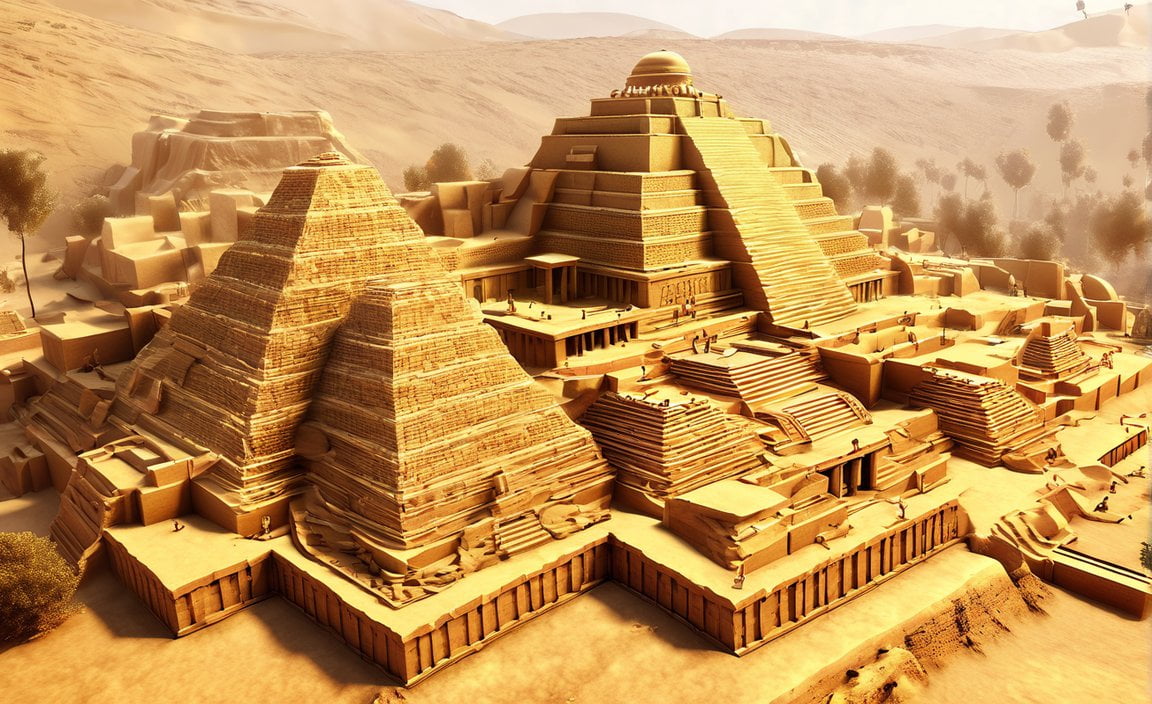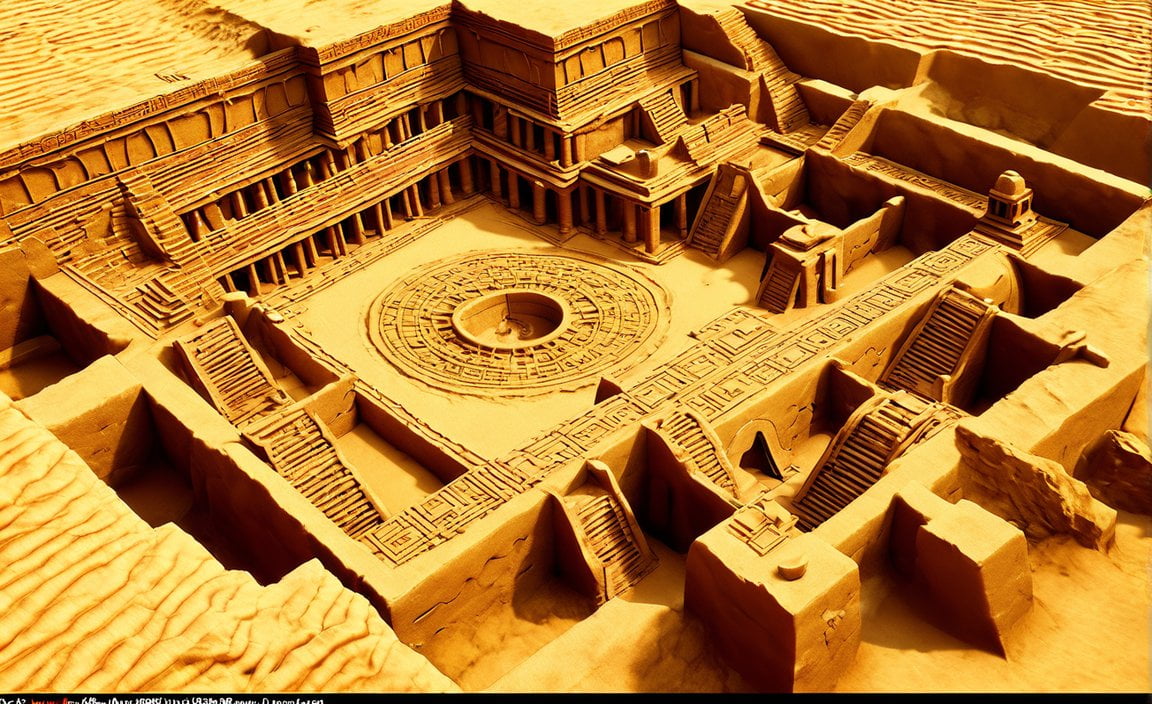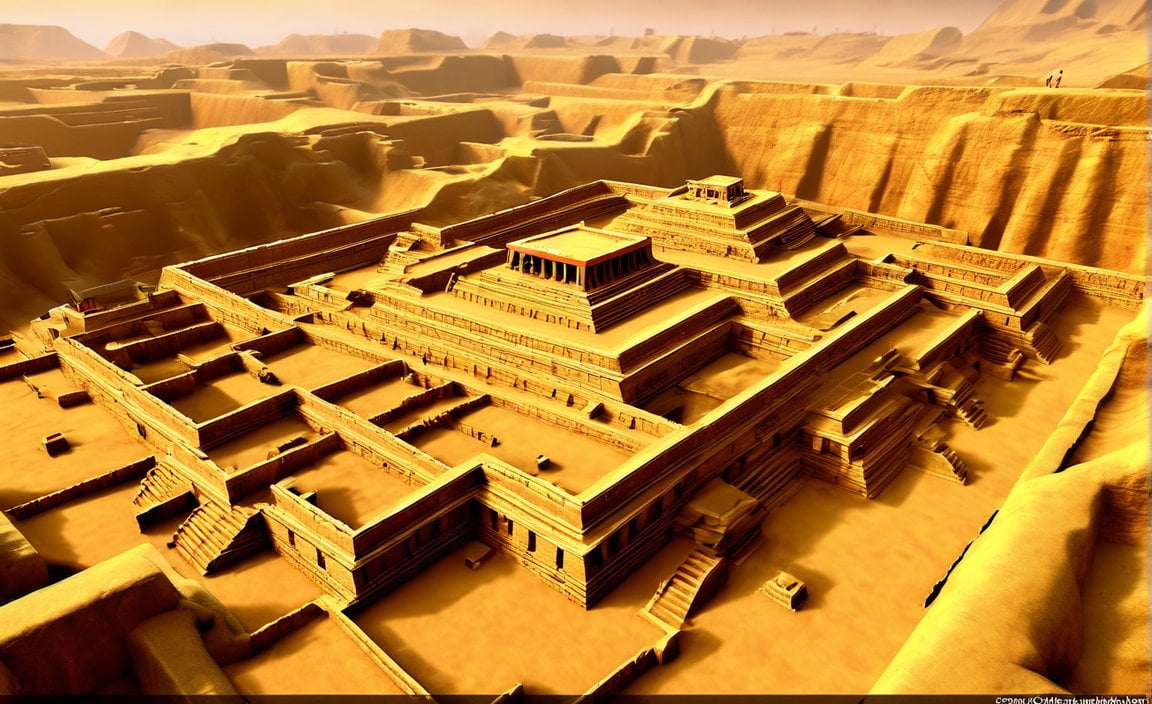Discover 5 Fascinating Facts About the Indus Valley Civilization. Journey back in time as we uncover the secrets of one of the world’s oldest and most mysterious ancient civilizations. From advanced urban planning to the enigmatic script, the Indus Valley Civilization continues to captivate archaeologists and historians alike. Join us on this exploration as we reveal five intriguing facts about this ancient culture that once thrived in the fertile plains of the Indus River in present-day India and Pakistan.

Key Takeaways:
- The Indus Valley Civilization was one of the world’s first large civilizations, with more than 1,400 towns and cities.
- It began nearly 5,000 years ago in modern-day Pakistan and Northern India.
- The civilization developed the oldest script, which remains undeciphered to this day.
- It had a sophisticated drainage system and invented various items such as weights, seals, and pottery.
- The ancient rulers of the Indus Valley Civilization were known for their precise measurements of length, mass, and time.
5 Facts About the Indus Valley Civilization
The Indus Valley Civilization, one of the world’s earliest and most advanced civilizations, holds many fascinating secrets waiting to be discovered. Let’s delve into the intriguing world of this ancient civilization and uncover five captivating facts.
1. A Magnificent Network of Cities
The Indus Valley Civilization boasted an impressive network of over 1,400 towns and cities ^1^. This thriving civilization emerged nearly 5,000 years ago in the region that is now Pakistan and Northern India ^1^. Imagine the bustling streets, the vibrant markets, and the intricate social fabric that wove these cities together.
2. The Enigma of Indus Script
Among the remarkable achievements of this civilization is the oldest script ever discovered, the Indus script. Despite extensive efforts, this ancient form of writing remains undeciphered, leaving us tantalized with curiosity and intrigue ^1^. What messages and stories lie within these mysterious symbols? Only time will tell.
3. Engineering Marvels
The Indus Valley Civilization was well ahead of its time when it came to engineering. Their impressive drainage system, designed to channel excess water and maintain cleanliness, showcases their advanced understanding of urban planning ^2^. Additionally, this civilization introduced a range of inventions such as weights, seals, and pottery, revealing their ingenuity ^2^.
4. Precision in Measurements
The ancient rulers of the Indus Valley Civilization were revered for their precise measurements of length, mass, and time ^2^. They employed meticulous techniques to ensure uniformity in weights and measures. Their dedication to accuracy in these areas demonstrates their sophisticated mathematical and scientific knowledge.
5. The Misleading Name
Although commonly known as the Indus Valley Civilization, only a small fraction of its sites can be found along the Indus River. In reality, this civilization covered a vast area that extended far beyond the riverbanks. It is estimated that over 1,056 cities and settlements were part of this magnificent civilization, with 96 of them having been excavated so far [^3^]. The significance of this civilization reaches far beyond the banks of a single river.
In conclusion, the Indus Valley Civilization holds an extraordinary place in the annals of history. Its intricate cities, fascinating script, innovative engineering, precise measurements, and vast geographical reach all contribute to a captivating story waiting to be fully unraveled. By delving into the mysteries of this civilization, we gain a deeper understanding of our collective human heritage.
Here are some fascinating facts about different subjects that will surely pique your curiosity:
-
5 facts about animal welfare – Discover the essential and eye-opening truths about animal welfare that will make you rethink your perspective.
-
5 facts about common snapping turtles – Uncover the captivating and sometimes surprising details about common snapping turtles that will leave you amazed.
-
5 facts about lakes and ponds – Dive into the mesmerizing world of lakes and ponds with these mind-blowing facts that will make you appreciate their beauty even more.
-
5 facts about marine animals – Explore the depths of the ocean and unravel the secrets of marine animals with these intriguing facts that will leave you awe-inspired.
So, what are you waiting for? Click on the links above to embark on an exciting journey of knowledge and discovery!
Sophisticated Drainage and Sanitation Systems
The Indus Valley Civilization, one of the oldest and most fascinating ancient civilizations, was not only known for its remarkable engineering and architectural planning but also for its sophisticated drainage and sanitation systems. In this article, we will delve into five intriguing facts about the Indus Valley Civilization’s exceptional drainage and sanitation systems.
Fact 1: Well-Organized Wastewater Drainage and Trash Collection Systems
One of the standout features of the Indus Valley Civilization was its well-organized wastewater drainage and trash collection systems. Excavations of the civilization’s remains reveal a remarkable level of sophistication in managing sanitation and waste. The cities, such as Harappa and Mohenjo-Daro, had an efficient network of underground sewage drains connected to houses, public buildings, and the streets. The system was designed to channel wastewater away from the living areas, ensuring a cleaner and healthier environment.
Fact 2: Latrines, Bathing Houses, and Sewage Drains in Houses
In addition to the city-wide drainage system, individual houses in the Indus Valley Civilization were equipped with their own sanitation facilities. The houses had indoor latrines with brick or stone seats, providing a hygienic solution for waste disposal. Moreover, many houses had separate bathing areas, indicating the civilization’s emphasis on cleanliness and personal hygiene. These bathing areas were connected to the sewage drains, further highlighting the advanced sanitation practices of the Indus Valley Civilization.
Fact 3: Similarity of Drainage Systems in Taxila and Mohenjo-Daro
The drainage systems discovered at Mohenjo-Daro, one of the largest cities of the Indus Valley Civilization, bear a striking resemblance to those of Taxila. This similarity suggests that the people of ancient India experienced with sanitation and wastewater management shared their knowledge and best practices with neighboring cities. The presence of such advanced drainage systems across different cities of the civilization paints a comprehensive picture of a society that valued cleanliness and put great emphasis on efficient sanitation practices.
Fact 4: Sophisticated Water Supply and Irrigation System
Alongside its impressive drainage and sanitation systems, the Indus Valley Civilization also boasted a remarkable water supply and irrigation system. The civilization had access to clean water through wells, reservoirs, and even sophisticated water tanks like the famous Great Bath. These structures were intricately designed to provide a steady flow of freshwater for domestic use, irrigation of fields, and support for various crafts and industries. The advanced water management reinforces the ingenuity and foresight of the civilization’s engineers.
Fact 5: Indications of Social Stratification and Craft Specialization
The existence of such sophisticated drainage and sanitation systems within the Indus Valley Civilization speaks volumes about the socio-economic stratification and division of labor within the society. The presence of well-planned sewage systems, high-quality infrastructure, and efficient waste management suggests the involvement of skilled engineers and craftsmen who dedicated their expertise to the construction and maintenance of these systems. This craft specialization hints at a society that valued various professions and possessed a sophisticated understanding of urban planning and sanitation.
Key Takeaways:
- The Indus Valley Civilization had well-organized wastewater drainage and trash collection systems, as evidenced by extensive excavation findings.
- Individual houses in the civilization had their own latrines, bathing houses, and sewage drains.
- The similarity of drainage systems in different cities suggests the spread of knowledge about sanitation and wastewater management.
- The civilization also had a sophisticated water supply and irrigation system, ensuring a steady flow of clean water for daily use and agricultural purposes.
- The presence of advanced drainage and sanitation systems indicates the division of labor and craft specialization within the civilization’s society.
Sources:
– learnodo-newtonic.com
– The Archaeologist
Indus Script and the Mystery of Decipherment
The Indus Script continues to intrigue researchers, archaeologists, and linguists alike with its undeciphered nature and unique characteristics. Let’s delve into the mystery of the Indus script and explore five fascinating facts about its enigmatic symbols.
Fact 1: An Undeciphered Script
The Indus Script, discovered during the excavation of Harappa, remains a puzzle yet to be solved. Despite numerous attempts, scholars have not been able to fully decipher its meaning and purpose[^1^]. Just imagine the excitement of unraveling an ancient code that has remained a mystery for centuries!
Fact 2: Discovered During the Excavation of Harappan City
One of the greatest cities of the Indus Valley Civilization, Harappa, revealed the existence of the Indus Script. Excavations in this ancient city unearthed artifacts with inscriptions, offering tantalizing glimpses into the ancient civilization’s written communication[^2^]. The discovery of the script added another dimension to our understanding of the Indus Valley Civilization.
Fact 3: A Piece of Evidence for the Existence of Indus Valley Civilization
The Indus Script serves as concrete evidence supporting the existence of the Indus Valley Civilization. Inscriptions found on pottery, stamps, and other artifacts demonstrate the use of written communication within this ancient civilization[^3^]. The script connects us to a time and people who laid the foundation for our present civilization.
Fact 4: Use of Exotic Materials for its Inscription
Unlike modern scripts written on paper, the Indus Script was inscribed on various exotic materials. Seals and pottery were often adorned with these enigmatic symbols[^4^]. The choice of materials offers a glimpse into the materials and resources available at the time, reinforcing the craftsmanship of the Indus Valley Civilization.
Fact 5: Oldest Script of the Indus Valley Civilization
The Indus Script predates other early writing systems like cuneiform and hieroglyphics, making it the oldest known script associated with the Indus Valley Civilization[^1^]. Its age adds to its enigma and highlights the sophisticated intellectual capacity of the civilization.
The mystery surrounding the Indus Script continues to captivate archaeologists and linguists worldwide. Researchers laboriously analyze and compare the script’s symbols, hoping to uncover its secrets and shed light on the ancient Indus Valley Civilization. As more research, discoveries, and technological advancements occur, we may inch closer to deciphering this ancient script and uncovering the mysteries hidden within.
Key Takeaways:
– The Indus Script remains undeciphered, posing a challenge to scholars who have attempted to unravel its meaning and purpose.
– It was discovered during the excavation of the Harappa city, shedding light on the ancient civilization’s written communication.
– The existence of the script serves as evidence supporting the existence of the Indus Valley Civilization.
– The Indus Script was inscribed on materials like seals and pottery, providing a unique and fascinating aspect of the civilization’s craftsmanship.
– Predating other ancient writing systems, the Indus Script stands as the oldest script linked to the Indus Valley Civilization.
For more information on the Indus Script, consider referring to the following sources:
[^1^]: Wikipedia: Indus Script
[^2^]: HistoryTen: 10 Interesting Facts About the Indus Script
[^3^]: HistoryTen: 10 Interesting Facts About the Indus Script
[^4^]: HistoryTen: 10 Interesting Facts About the Indus Script
Indus Valley Trade and Cultural Connections
Key Takeaways:
- The Indus Valley Civilization had a highly developed trade network, connecting them with various regions and cultures.
- The civilization was known for its advanced architectural structures and engineering techniques.
- The Indus Valley Civilization had a sophisticated drainage and sanitation system, surpassing many contemporary urban cities.
- The civilization had a writing system that remains undeciphered, showcasing their communication skills.
- The decline and end of the Indus Valley Civilization remain a mystery, leaving room for speculation and further research.
The Indus Valley Civilization, which emerged around 5,000 years ago in what is now Pakistan and Northern India, was not only known for its grand cities and architectural marvels but also for its extensive trade and cultural connections. Let’s explore five fascinating facts about the Indus Valley Civilization, shedding light on their trade networks and cultural interactions.
Fact 1: Developed Trade Network
The Indus Valley Civilization had a highly developed trade network, connecting them with various regions and cultures. Archaeological evidence suggests that they engaged in long-distance trade with Mesopotamia, present-day Iraq and Iran, as well as with regions in Afghanistan and Central Asia. The trade routes were vital for the exchange of goods such as textiles, precious stones, metals, and agricultural products. The well-established trade network contributed to the prosperity and economic growth of the civilization.
Fact 2: Cultural Exchange
Due to their flourishing trade network, the Indus Valley Civilization had frequent cultural exchanges with the regions they traded with. This cultural exchange is evident in the presence of Mesopotamian and Persian artifacts found in Indus Valley cities like Harappa and Mohenjo-Daro. The presence of these artifacts suggests that there was a significant exchange of ideas, artistic styles, and even technologies between the civilizations. This cultural assimilation demonstrates the civilization’s openness to new influences and their commitment to connecting with other cultures.
Fact 3: Advanced Architectural Structures
The cities of the Indus Valley Civilization were engineering masterpieces. The Great Bath at Mohenjo-Daro is one of the most famous structures of the civilization. It showcases their advanced knowledge of water management and sanitation. The bath was built with waterproof bricks and had a complex system of drains and water supply. This attention to hygiene and infrastructure highlights the civilization’s commitment to public health and cleanliness, aspects that were crucial for their trade and cultural interactions.
Fact 4: Undeciphered Writing System
The Indus Valley Civilization had a writing system that is still undeciphered. The script, which was discovered during the excavation of the ancient city of Harappa, remains a mystery to scholars. Despite extensive research, the meaning and purpose of the script remain elusive. Inscriptions of the script have been found on various artifacts, including pottery and seals, indicating its importance in written communication. The undeciphered script emphasizes the civilization’s highly developed level of communication and the challenges that exist in understanding their written records.
Fact 5: Decline and Legacy
The decline and end of the Indus Valley Civilization remain unclear. Several theories propose factors such as environmental changes, social unrest, and invasions as potential causes. However, there is no definitive conclusion. The mystery of their decline and the abrupt end of their urban civilization leave room for speculation and ongoing research. Despite their decline, the Indus Valley Civilization’s legacy continues to inspire modern research and ignite curiosity about ancient civilizations.
In conclusion, the Indus Valley Civilization’s trade network and cultural connections played a significant role in their existence and development. Their expertise in trade and openness to cultural exchange facilitated the growth of their civilization. Today, as we uncover more about this fascinating ancient civilization, we are reminded of the importance of trade and cultural connections in shaping our world.

FAQ
Q1: How old is the Indus Valley Civilization?
A1: The Indus Valley Civilization began nearly 5,000 years ago in an area of modern-day Pakistan and Northern India.
Q2: How many towns and cities did the Indus Valley Civilization have?
A2: The Indus Valley Civilization had more than 1,400 towns and cities at its peak.
Q3: What inventions did the Indus Valley Civilization have?
A3: The Indus Valley Civilization had inventions such as a sophisticated drainage system, weights, seals, and pottery.
Q4: What is known about the script of the Indus Valley Civilization?
A4: The script of the Indus Valley Civilization remains undeciphered to this day, and it is the oldest script associated with the civilization.
Q5: How many sites are found along the Indus River?
A5: The name “Indus Valley Civilization” is a misnomer, as only about 100 sites are found along the Indus River.
- Unraveling Einstein’s Legacy: Who Inherited His Genius? - July 14, 2025
- Unlock Einstein’s Family Tree: Bernhard Caesar & Untold Stories - July 14, 2025
- Unveiling Bernhard Caesar Einstein: His Life & Albert Einstein’s Legacy - July 14, 2025



![Saving the [Example of Endangered Species in Pakistan]: A Call to Action for Conservation Efforts example-of-endangered-species-in-pakistan_2](https://www.lolaapp.com/wp-content/uploads/2023/12/example-of-endangered-species-in-pakistan_2-150x150.jpg)












